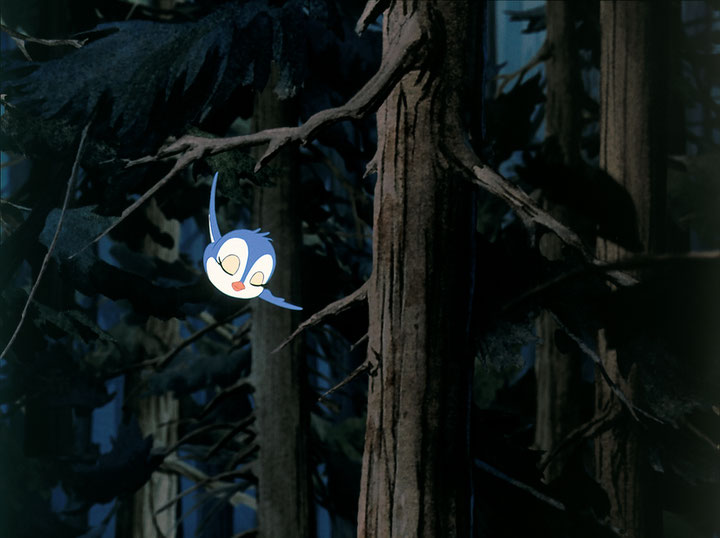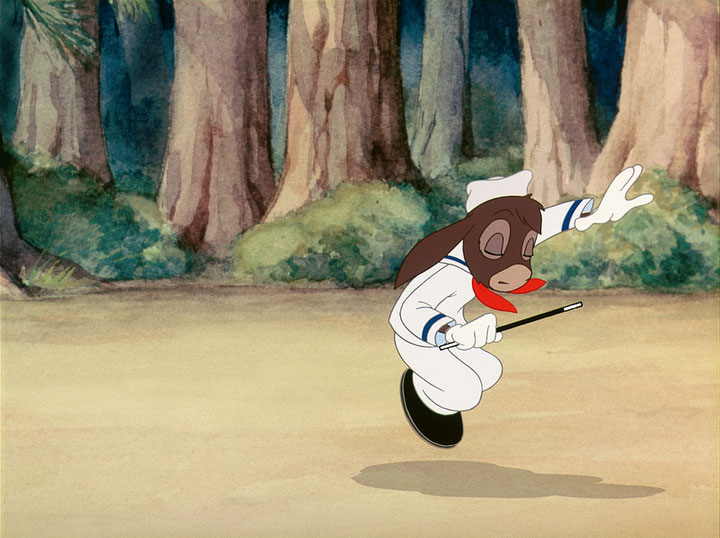Issue 4/2013 - Kunst der Verschuldung
Hyperarticulation and crisis
Interview with artist Mathias Poledna on his new work Imitation of Life (2013)
At this year’s Venice Biennale Mathias Poledna took the Austrian pavilion as the showcase for his three-minute animated film Imitation of Life. Entirely in keeping with the aesthetic of classic Disney cartoons from the 1930s, Poledna portrays a small singing donkey in a sailor’s suit dancing through a fairytale forest. Looking at first glance like a highly compact, self-contained work, the piece proves upon closer examination to be shot through with a host of caesurae and montage elements.
Alexandra Seibel: Both the Venice work Imitation of Life and your previous piece A Village by the Sea (2011) pick up on the aesthetic of Hollywood’s golden age. The studio system of that era responded to the global economic crisis with enormous “production values” – a utopian alternative blueprint that also becomes tangible in your films. How do these two works relate to the current crisis?
Mathias Poledna: The crisis, which actually peaked a few years ago yet continues to have a huge impact, was an important starting point, as indeed was the entire concluding chapter of the Bush era. Generally speaking, my interest in phenomena of the past evolves out of contemporary considerations: the conceptual connection between the Depression era and the recent past was however aimed not so much at finding correspondences but focused more on taking a look at the construction of certain images. What made animated films and musicals from that period so intriguing for me in the first instance was their enormous artificiality and the extreme formulation of their respective aesthetics – you might call this hyper-articulation. The images and to a large extent also the sounds in these works are in a sense the fundamental building blocks of our collective perception of culture and as such are part-and-parcel of the essential experiences of modernism and modernity.
Seibel: In the course of the presentation of Imitation of Life, the production context and the huge number of man-hours this entailed were resolutely underscored: the creation of over 5,000 individual images, recruitment of a large team of professional Hollywood cartoonists, with the musical accompaniment recorded by a 52-person orchestra. To what extent does this detailed information about the production background form part of the work that is exhibited?
Poledna: I try to realize my works in a way that renders them independent of any special knowledge. Information about the production context, accompanying texts or publications can supplement, expand or even contradict the modus in which these works can be read. Production credits are in the first instance a tribute to the many people who were involved in the production; they also reference the constructed nature of the work, which distinguishes it from utilisation of existing material or from ready-mades. In the case of Imitation of Life, I found the relationship between the ephemerality of a three-minute film and the effort required to make it an interesting conceptual frame, which sheds light on historical production contexts, even if these by no manner of means coincide with the conditions shaping this production. I am interested in all these possibilities in as much as they constitute an offer, which one can either respond to or ignore. That does not signify that the meanings of a work are contained within the work itself; quite the contrary. In my view, the relationship between photography and the index, as explored for example by Brecht and Benjamin, does not mean either that an index must be made available. In many cases the tension in my works stems from absences and voids, even when they at first appear to be “complete”. The lack of an index is itself an index.
Seibel: You emphasise highly detailed, analogue adaptations of historical animated film, as found in the Disney Studios of the 1930s and 1940s. What makes re-enactment of these manual practices so important? What kind of potential is unleashed by the processes of pastiche you use in this context?
Poledna: I am interested in the first instance in the aesthetics and filmic language of this era. The production method per se is important for me only to the extent that it allows me to move closer to these concerns and to deal with them. There is of course something fundamentally performative in the production of films, and this process played a central role in my earlier works, such as Version und Sufferers’ Version (both 2004). In terms of the production background of a 1930s animated film, it is generally only possible to achieve an approximation. Certain technical conditions cannot be reproduced. The enormous multiplane cameras, for example, which were used to create the illusion of spatial depth for particular scenes, have only survived in museums, but the effects created with this technology can be reconstructed with contemporary means. Attempting to reproduce historical forms of division of labour would possibly be interesting as a social experiment, but would not necessarily be beneficial for the outcome. What makes the production methods for animated films in general so fascinating is their almost allegorical relationship to the capitalism of their day. It is no coincidence that in a certain sense caricatures of semi-industrial, Taylorist and Fordist division of labour pop up in a whole series of short films from this period (Santa’s Workshop, 1932, Funny Little Bunnies, 1934, The Wise Little Hen, 1934, Broken Toys, 1935). Their content is a direct result of rationalisation processes in their production.
Seibel: In Disney’s Pinocchio (1940) “lazy” boys are turned into donkeys and sold as a manpower. This punishment – the transformation of a free subject into an inarticulate creature – is performed as a horrible disciplinary measure. In your work the donkey becomes a lyrical-melancholy hero wandering through a fairytale forest, singing and dancing as it goes. Is the emphasis here on deliberately re-codifying the marginalised Disney figure?
Poledna: I see the donkey in the film as an autonomous, albeit contradictory figure, which can be viewed as loosely related to various archetypical possibilities of the era. We do not in the first instance associate the donkey with wild animals, yet it is not a pet either. It is a working animal, a slave, in a certain sense. However, the sailor’s suit that the donkey wears and the situation in which we encounter it transmit different signals, which do not however really allow us to draw unambiguous conclusions. In the course of the film’s short sequence of scenes the donkey ultimately seems to experience various different identities.
Seibel: The title Imitation of Life references Douglas Sirk’s eponymous Hollywood melodrama. In that film the question of skin colour and of being able to “pass” as a white subject plays a central role. The dark-skinned donkey in the white sailor suit, inter alia performing tap dances, suggests associations with “blackface”. What role does the idea of “otherness” play in the conception of the titular character?
Poledna: I think that the figure is consciously constructed in a way that allows a multiplicity of readings, including the one that you have mentioned. Stereotypes and projections are in a sense animation’s raw materials. First of all, the alien nature and also the alienation of the donkey in the scene around him are important motifs. Over and above this, I was interested in links to early forms of mass entertainment, such as vaudeville and slapstick, and specifically also in the influence of various Afro-American figures on the musical as a genre. The vocabulary of movements of someone like Fred Astaire is inconceivable without the inventions of contemporaries and predecessors such as John W. Bubbles or Bill Robinson. For his part, black actor and comedian Stepin Fetchit, whose embodiment of a crassly racist stereotype, the “laziest man in the world”, made him a huge star in the 1930s, was often parodied in animated films. And finally, the almost complete “whiteness” that we are confronted with in musicals from the studio system cannot conceal the fact that they draw their musical material from the cultures of Afro-Americans and other minorities. In this sense Imitation of Life could also be read as a kind of fragmentary archaeology of the American cultural industry.
Seibel: The song the donkey starts to sing, “I’ve Got a Feelin’ You’re Foolin’”, comes from the musical Broadway Melody of 1936 (1935), where it is sung as a duet about the (deceptive) magic of love. Your donkey sings alone and he does not answer the question put to him about what he is actually doing in the forest. What status do these displacements (from musical to cartoon, from duet to solo) and confusions assume?
Poledna: The connections between 1930s musical films and animated films from the same era are enormously diverse. Animated short films were produced to be shown before feature films; their ties to music were already obvious in the titles of the series in which they were marketed – Silly Symphonies (Disney), Merrie Melodies and Looney Tunes (Warner Brothers), Happy Harmonies (MGM) etc. Picking up on popular film songs was just as common as parodies of famous film stars, ranging from W. C. Fields to Katherine Hepburn. In Imitation of Life the adaption and reshaping of the musical material is tailor-made firstly for the animation genre and then specifically for the figure of the donkey and the loose narrative framework in which he appears. The musical languages of musicals and animation do indeed overlap in many respects but are by no manner of means identical. When it comes to the lyrics, certain key terms – “fooling”, “frame”, “hocus pocus” etc. – that initially piqued my interest in the original song, are preserved unchanged, even if they now take on an almost existential dimension.
Seibel: As Esther Leslie elucidates in her text for the catalogue, Sergei Eisenstein welcomed Disney’s perfect mastery of the technical means of production and his blueprints for magical, colourful worlds as a revolution against “mental stagnation and inconsolability”. At the same time Eisenstein viewed this revolt as “lyrical” or as a “daydream”. Your film also plays with the boundaries between waking and sleeping: the donkey is woken up by a bird, launches into a song and begins to dance through the fairytale forest. To what extent does this tension mark your relationship to Hollywood’s mass entertainment industry?
Poledna: The interesting thing about Eisenstein’s analysis is that the counter-world to the misery of everyday life that he finds in the visual language of animation at the same time also corresponds to the false appearance that materialist critique identifies in the entertainment industry’s products. The kind of idea of the dream that Benjamin derives from his reading of Surrealism in a sense synthesises this contradiction, but it runs through the entire reception of modernity. The logic of the dream also links animation to analyses of the commodity form, for after all the permanent difference between what we believe we see in one moment and what we recognise the next moment is one of the foundations underpinning such analyses right from the outset. The transformations, melting, metamorphoses and dissolves that we encounter constantly in animated films not only recall the precarious status of objects but also the transitory nature of the capitalist economy in its entirety, all the more so in that animation itself is a product that is manufactured, so to speak, out of nothing. .
Translated by Helen Ferguson



